Karen Page is dead. She became a heroin addict, a porn actress, was lied to to convince her she had AIDS, and was killed by Bullseye. Bullseye has not suffered enough for this. But though he lives, Karen Page does not. She has become a tragic figure and I don’t think her death has ever really been absorbed in the ethos of comics.
The rule that was Bucky and Uncle Ben don’t come back, that rule does not now include Karen.
In Kevin Smith and Joe Quesada’s Guardian Devil (1986) we see that death in all its tragedy. Jeph Loeb and Tim Sale (2002) give us both a foreshadowing and a retrospective to the relationship in Daredevil Yellow. Daredevil Yellow?
When Daredevil began, he did not wear red; he wore yellow, black, and red. It is his period in that costume – the first seven issues of his comic — that is covered in this story. The graphic novel balances all the story lines of the original issues, but it gives the supervillains much less emphasis.
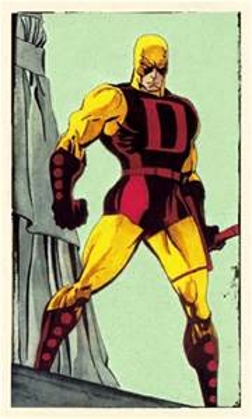
Thighs, seriously, if you keep cushioning your impact in a wall with your legs, you’re gonna get thighs.
Comic books were originally a genre of action with very little character development. In this comic that is totally overthrown.
There is action here, but it supports character development brilliantly. And in that this story is very focused. It’s a romance, but not one with a happy ending.
The artwork is a little stylized and that might not be to everyone’s taste. I find it engaging and I like the small touches. The use of scale in the hands that hold the photo that show Jack Murdock towering over his son while Matt Murdock thinks about his father’s influence over his own life is a great single panel. And I like that it’s something you can’t do in text, like in a novel or a short story. Text would be more clumsy with that message.
Another advantage of comics is not everything has to be mentioned in text. A novel has to say things out loud, trying to find some way to make a reader pass over them. Really, the novel’s job at those points is to distract or even bore the reader. Not so in graphic novels.
Daredevil’s thighs are never mentioned in text anywhere in this book, but if you look at the drawings you’ll see Daredevil has larger thighs than even most athletes. The people who work out and have thighs like that are dancers, wrestlers, and boxers (more the former two than the last). I could go through the reasons for this, but they don’t matter unless you already know what the extra muscles are for. It is a very professional touch in a book which already upholds a high standard.
The true focus of the book, though, is character. It focuses not on super villains but on Matt Murdock’s developing relationships, particularly with Karen Page but also with his own dead father and to a lesser extent, Foggy Nelson.
In the story, Matt is remembering Karen Page, who has already died in Guardian Devil. So his father’s death is one book end, and Karen Page’s is the other. And his life is an arc from one death to another, but all encompassed by the first seven issues of his comic.
It was the time of his yellow, black, and red costume before that got changed. Except for the first and last scenes, when he wears the iconic red. Like I said, bookends. But also character development shown in a way new to this book.
Throughout the years, Matt Murdock/Daredevil has had a history of bad relationships with women. We never see his mother. Of adult relationships with women he basically has four. These are Karen Page (becomes a porn star, an addict, and dies), the Black Widow (is not going to put up with that crap and leaves), Elektra (is a psycho assassin who gets killed), and Typhoid Mary (draws people into her psychotic weirdness and kills them).
Daredevil Yellow is about Karen’s death long before it happens. It’s an unusual story structure for any genre, but it’s done really well, here. The weaknesses that lead Karen Page down her path to destruction and Matt Murdock down the path to what may turn out to be his destruction are shown as they begin. They do make some changes to the story, but not in the actions as in the character arcs.
For example, the confidence Daredevil originally felt in the early comics is no longer there from the start. Much more realistically, he gains confidence after victory in his battle with Electro and some fawning attention from some Rockettes – that makes sense.
And this shows how the various threads are woven together so well. Electro takes it that Daredevil wants to beat him to get a reputation. He tells Daredevil to “stick with the small time wiseguys with their popguns.” This attitude is pure boxing, a win puts you up in ranks. This could be the trash talk of two boxers. In the original story, Electro is just a villain. Here he echoes Jack Murdock’s influence over Daredevil’s life.
On the other hand, the dancers asking Daredevil if he’s married, or if he has a girlfriend, entwines with the story of Daredevil and Karen Page.
The whole is made more powerful in that this is Daredevil right after his cruel killing of the Fixer, the man who killed Matt Murdock’s father. Vengeance for his father is the earliest theme. And the honorable superhero is not part of the Fixer’s final moments.
And while Matt is going through the changes driven by getting his father justice, then realizing that job is almost done and he’s still putting on the costume. Why is he doing that?
But in a few panels, without doing anything directly, Daredevil Yellow shows us Karen Page’s death warrant being signed years before it happened. This is the brilliance of the book. Those few panels are enough to recommend the book on their own.
That’s where Karen Page comes in most strongly. Her story is she was looking for a job and got caught up in the fact one of her bosses is a blind superhero. And both her bosses have the hots for her. And she is not prepared for any of that. She is still an ingenue, but there is a person within the drawings.
The triangle of Nelson-Page-Murdock is better handled than it was in the original issues. All three of them are shown as uncertain not simply about approaching each other but making approaches at all. Foggy tries breaking through with some bravado that never once works. Matt is more reserved at first. In the end that works to his advantage.
As for Karen, she is still an innocent even though that isn’t what’s popular at the moment. She is uncertain, unaware of the consequences of events, and unable to work out what other people are about. She becomes the hostage girl, forcing Daredevil to protect her.
On the other hand, just drawn in and never once mentioned in the text are certain expressions on her face. I won’t give it away. I’ll let you read the comic, look at the panels and see if you get the regular progression, the subtext that I get.
As with the original issues, Karen becomes the hostage girl. She becomes the physical hostage of the Owl and then the mental hostage of the Purple Man. The shift between physical and mental is better used here than in the comics, where that kind of depth just didn’t exist. On the other hand, the use of Daredevil’s blindness in both instances makes an excellent counterpoint and it is straight from the comics.
Although the Matador is mentioned, thankfully that is all the panel time he gets. A single panel mention. Fair enough, he really was a boring supervillain. But he also never got hold of Karen Page so he is not part of that story.
Good. He sucked.
But Mr Fear and his henchmen, the Ox and the Eel, are not part of the story, either. They’re not even mentioned. But there is one obvious reason for this. They never got hold of Karen Page so they don’t form part of that arc of story. The pattern holds.
What the Owl and the Purple Man accomplish is they bring Daredevil and Karen Page together. Daredevil is designed to keep the heat off Matt Murdock, to allow him to express his own personality without being known for it. It is what keeps Matt Murdock true to his dead father’s wish: that Matt Murdock never be known as a fighter, as someone one step away from being a punk, to keep him from being dirty.
The oath Matt took, swearing to live by what his father said, then twisting the meaning as he did, is a lot more lawyer-like than most people have noticed. Keep to the letter of what he promised but twist the spirit until it is broken and weeping. Then deny all responsibility.
Lawyers. They are proof the Devil exists.
And as we know, the Devil sometimes bites himself.
Scattered through the story is the fact that Matt Murdock intends much better than he achieves. The intertwined plots and subplots illustrate the conflicting interests and influences in Matt Murdock’s life and psyche. He is not the master of himself, though he keeps trying.
Daredevil saves everyone except those closest to himself. His father, Karen, and in a way even Foggy.
This book explores the difference. It examines why he can’t save these people, and what it is he’s really trying to save them from.
As you’ve no doubt noticed, there is a lot to this book. It offers everything from giving more nuance to early comic book stories, through being a prequel which gives a sense of inevitable downfall, through to a tragic romance. It is a book of depth and nuance, and well worth multiple reads over time. You will find things you missed the first time through.
But what you will get soon and will stay with you is that Karen Page is on a path that seems so inevitable but is not. We have a habit of looking for signs, seeing signals that only mean something because we know what’s coming later. What do those expressions on Karen Page’s face mean? If they change the ending of her life, they could mean very different things.
But no matter what, it brings us back to the longest comic book death for a significant character since Bucky (whose death lasted from 1964 to 2005). Karen Page’s death (1999 – present) is about 17 years old. That’s not as long, no less significant, but too impactful, perhaps, to have an impact. People can’t deal with it enough to make it part of the mythos. Comicdom is still in denial about her death.
Karen Page is dead, Guardian Devil was her death, Daredevil Yellow is her eulogy.

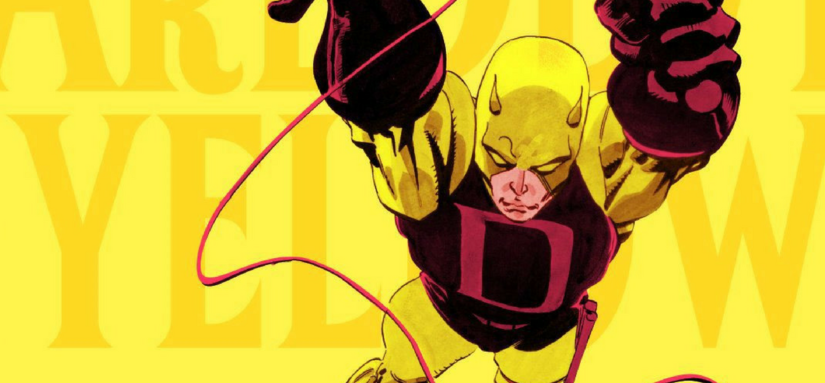
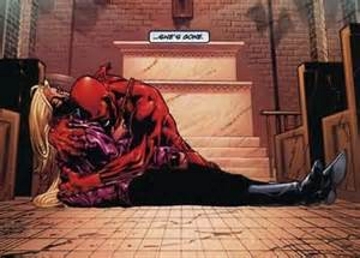
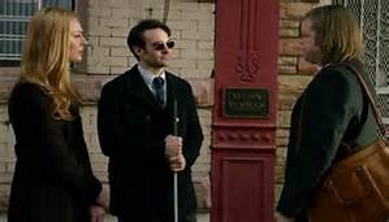

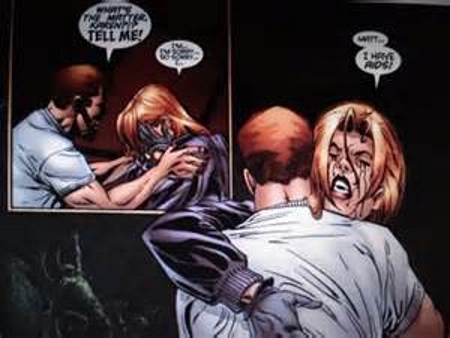
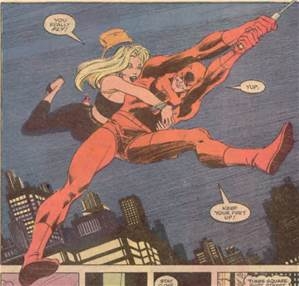
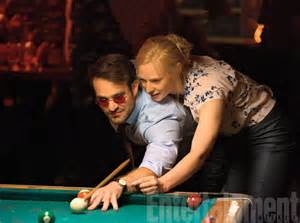
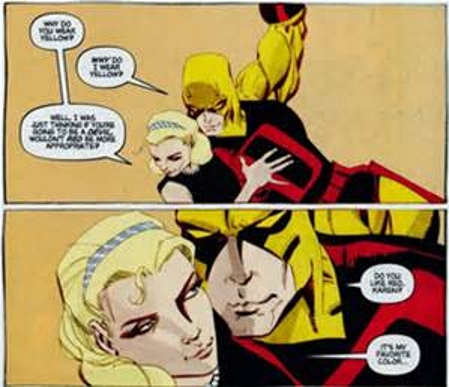
Comments are closed.